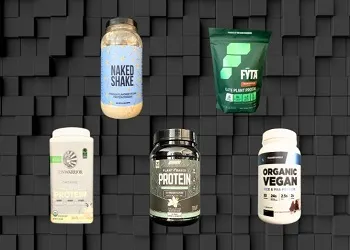So, how much amino acids should I take to avoid amino acid imbalance? Understanding the impact of excess amino acids in the body can reduce the likelihood of supplement abuse and promote greater health benefits.
Table of Contents
Quick Takeaway:
- Excess amino acids in the body are classified as an unnecessarily high intake of any particular amino acid.
- Consuming excess amino acids can result in an imbalance in the body and drastically increase toxicity levels to negatively impact health.
- Different amino acids, like essential and nonessential, have prominent roles in the human body to support health. Still, there are other notable classifications of amino acids, including free-form and aromatic amino acids, to be aware of.
- Though amino acid supplementation is incredibly popular, there are some potential risks of unnecessarily high amino acid levels when unneeded. Consult a medical professional before beginning amino acid supplementation to avoid excess intake.
What Are Excess Amino Acids in the Body?
Like anything in excess, consuming too much amino acids can harm the human body. Excess amino acids are imbalances caused by surpluses of essential amino acids and disproportionate amounts of amino acids.
What Happens to Excess Amino Acids?
According to this study on the nutritional consequences of excess amino acid intake, large amounts of amino acids result in toxicities. When this occurs, plasma concentrations of the excess amino acids rise to significantly high levels.
Throughout the body, catabolism is increased by enzymes in the liver and other parts of the body. Alterations in the free amino acids in the brain are also affected. These amino acids signal the nervous system’s food regulation functions, resulting in affected eating patterns.
The Threat of Amino Acid Overdose
Excess amino acid intake leads to imbalances, negatively impacting one’s health. Though amino acids play vital roles in the body, supporting protein synthesis and other crucial functions, abnormal amino acid intakes of these organic molecules can be dangerous for one’s health.
“Some amino acids can compete for absorption, potentially affecting the levels of others. Additionally, excessive amino acids can strain the kidneys, as they play a role in eliminating nitrogen byproducts from amino acid metabolism,” states April Bruns, RDN, LD, and CPT.
Though antagonisms may arise from excess amino acid intake, the possible adverse effects from this can be relieved by consuming a structurally related amino acid. This can be counterbalanced depending on the type of amino acid being consumed in excess to avoid potential health concerns.
Excess Amino Acids — Types and Effects

Other than essential, nonessential, conditionally essential, and branched-chain amino acids (BCAAs), there are different types of amino acids that are included in each of these classifications. Whether it be the structure of the amino acids or how they function in the human body, presenting the differences between these amino acid types can provide a deeper understanding of the importance of amino acids for health.
Aromatic Amino Acids
Aromatic amino acids are labeled as any amino acid with an aromatic ring, which can be seen on the side chain of the amino acid. They play a part in protein synthesis and absorb ultraviolet light, with tryptophan having the highest absorbance rate.
Excess intake of aromatic amino acids can drastically escalate oxidative stress. This is due to their natural functions, which are involved in the production of reactive oxygen species (ROS). It was also revealed that excess aromatic amino acid intake caused growth retardation of the fetal brain, with fetuses having significantly lower weights than fetuses with normal intake.
Aromatic Amino Acids:
- Phenylalanine
- Tryptophan
- Tyrosine
Basic Amino Acids
Amino acids with basic side chains containing nitrogen and that resemble ammonia, a base, are called basic amino acids. These amino acids can bind proteins, have a positive charge, are hydrophilic, and are polar amino acids. In total, there are three of these organic molecules labeled as basic amino acids.
Basic Amino Acids:
- Lysine
- Histidine
- Asparagine
Free Form Amino Acids
According to the American Society of Nutrition, free-form amino acids are more readily available than intact protein. These amino acids serve as a currency for protein metabolism, though their concentrations are often low compared to their protein-bound form.
Free Form Amino Acids:
- Aspartic acid
- Glutamic acid
- Serine
- Glycine
- Alanine
- Praline
- Cysteine
- Valine
- Methionine
- Phenylalanine
- Isoleucine
- Leucine
- Lysine
- Histidine
- Threonine
- Asparagines
- Glutamine
- Arginine
- Tyrosine
- Tryptophan
Limiting Amino Acids
A limiting amino acid refers to an amino acid found in short supply in incomplete proteins, food sources that do not contain all 20 amino acids. This term can describe an essential amino acid in the lowest quantity in a protein source or an essential amino acid that does not meet minimal recommended requirements for human health.
The Most Limiting Amino Acids:
- Lysine
- Threonine
- Methionine
- Tryptophan
Neutral Amino Acids
Neutral amino acids refer to any amino acid with equal amino groups and carboxylic acid. These amino acids can become polar or nonpolar and share the same transporter in the intestinal mucosa and the brain.
The Impact of Overconsumption of Specific Amino Acids
Now that we’ve gone over the complexity of the different classifications of amino acids, which include nonessential and essential amino acids, what about the impact of overconsumption of specific amino acids?
Does excess intake of certain amino acids instigate more health dangers than others? Let’s ask the expert, April Bruns!
“The impact of consuming excess amino acids can vary depending on the specific amino acids involved. Disproportionate intake of individual amino acids may disrupt the balance of neurotransmitters in the brain,” reveals April (RDN).
Disrupting the balance of neurotransmitters in the brain can be dangerous. The imbalances in the neurotransmitter homeostasis have been connected to neurodegenerative and neurological disorders.
April explains, “An imbalance in amino acids can affect protein synthesis and potentially lead to issues like compromised liver function. It is important to consider the specific amino acids involved and their roles in the body and focus on getting a variety of amino acids through your diet by consuming high-protein foods.”
Amino acids are vital for supporting human health and promoting quality of life. Abusing intake, whether overconsumption of amino acid supplements or foods, can result in avoidable health risks.
The Impact of Amino Acid Supplements on Excess Intake

Eating foods rich in amino acids, especially complete proteins, is important for promoting a balanced diet to support health. When food consumption of individual amino acids does not meet recommended standards for intake, amino acid supplements are often used as an alternative to balance this out. The impact of taking amino acid supplements may result in excess intake, reveals expert April Bruns.
“Taking amino acid supplements, including popular ones like BCAAs, can increase the likelihood of excess amino acid consumption if not properly regulated,” reveals April. “While BCAAs are essential for muscle protein synthesis, excessive intake may disrupt the balance of amino acids in the body. This imbalance could impact overall health, including liver function and metabolic processes.”
Though supplementation can be beneficial for some individuals who have inadequate intake or unbalanced diets, often, these supplements are not needed. Following recommended dosage guidelines and consulting a medical professional before beginning supplementation is advised to deter potential health risks.
FAQs
How much amino acid should I take a day?
With amino acid supplementation, the most common dosage is 6g per day, though up to 30g per day has also been reported. The amino acid requirements for different age groups have been extensively studied. The recommendations in the table of the linked article provide the advised intake to promote health and deter health concerns.
What happens if you have an excess of amino acids?
Excess amino acids in the body that can’t be stored or used can be converted into ketones or glucose. The nitrogenous waste caused by the decomposition of these excess amino acids can result in high concentrations of nitrogen, causing toxicity in the body.
How do you remove excess amino acids?
The body naturally processes and removes excess amino acids. The excess amino acids are stored as glucose or ketones before the nitrogen waste is converted to urea and exits the body in urine.














